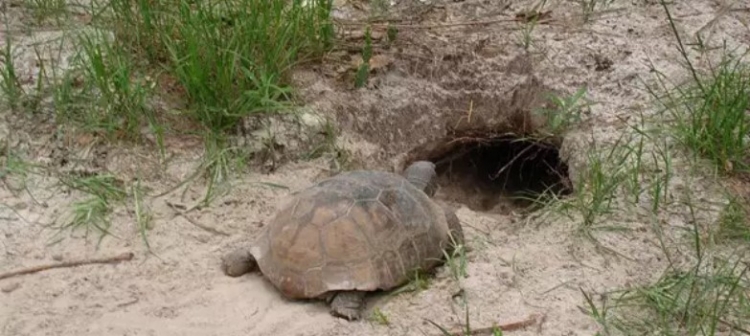How to get involved in gopher tortoise conservation
Florida Fish and Wildlife Conservation Commission (FWC)
With Florida's Gopher Tortoise Day being April 10, the Florida Fish and Wildlife Conservation Commission (FWC) invites you to get involved in conservation efforts with the state’s only native tortoise, a state-listed Threatened Species. The scientific name of the gopher tortoise is Gopherus polyphemus.
Florida residents play an important part in conserving gopher tortoises, which are often found living near people in suburban, agricultural and other developed areas. When people get involved in gopher tortoise conservation, it helps ensure that the more than 350 species of tortoises have shelter for in their burrows, and they will continue to be found throughout the state in the future.
Residents can get involved with conservation of gopher tortoises in several ways:
• If a tortoise appears healthy and is not in immediate danger, leaving the tortoise alone is usually the best option. If you see a gopher tortoise crossing a road and it is safe for you to do so, you may pick it up and place it in a safe location along the roadside in the direction it was heading. Never put tortoises in water, as gopher tortoises can’t swim like turtles can.
• Consider making your home and neighborhood gopher tortoise friendly by planting gopher tortoise friendly plants, such as broadleaf grasses, wiregrass, prickly pear grass, wild grape, blackberry or blueberry. Or you can create a Gopher Tortoise Friendly Yard; for details. visit myfwc.com/wildlifehabitats/wildlife/gopher-tortoise/yard-recognition. Where appropriate, you can place tortoise road crossing signs. Learn more about living alongside tortoises at the FWC’s Gopher Tortoise Program Education Corner at myfwc.com/education/wildlife/gopher-tortoise and the Education Resources Page at myfwc.com/education/wildlife/gopher-tortoise/education-resources.
• Consider volunteering with the FWC on gopher tortoise conservation efforts.
• Plan a Gopher Tortoise Day event, such as an educational activity, a local proclamation signing, a volunteer day or a wildlife appreciation festival.
• Report sightings of gopher tortoises and their burrows or notify the FWC of a sick, injured or dead tortoise here: app.myfwc.com/HSC/GopherTortoise.
• Remember that gopher tortoises are a protected species. It is illegal to harm a gopher tortoise, its eggs or its burrow, to relocate without a permit, or to possess a tortoise, its eggs, or any parts of a tortoise. Report wildlife violations to the FWC’s Wildlife Alert Hotline at 888-404-FWCC (3922).
Gopher Tortoise Day was adopted in 2016 by the Gopher Tortoise Council to increase appreciation and conservation support for this iconic Florida species. The FWC and partners celebrate this day each year. You can find events and proclamations near you by visiting GopherTortoiseDayFL.com and by using #GopherTortoiseDay on social media and internet searches.
Spring is an active time for gopher tortoises and many native wildlife species. Learn more by visiting myfwc.com/news/spring-news.
Find out more about Florida’s only native tortoise at MyFWC.com/GopherTortoise.
Top
With Florida's Gopher Tortoise Day being April 10, the Florida Fish and Wildlife Conservation Commission (FWC) invites you to get involved in conservation efforts with the state’s only native tortoise, a state-listed Threatened Species. The scientific name of the gopher tortoise is Gopherus polyphemus.
Florida residents play an important part in conserving gopher tortoises, which are often found living near people in suburban, agricultural and other developed areas. When people get involved in gopher tortoise conservation, it helps ensure that the more than 350 species of tortoises have shelter for in their burrows, and they will continue to be found throughout the state in the future.
Residents can get involved with conservation of gopher tortoises in several ways:
• If a tortoise appears healthy and is not in immediate danger, leaving the tortoise alone is usually the best option. If you see a gopher tortoise crossing a road and it is safe for you to do so, you may pick it up and place it in a safe location along the roadside in the direction it was heading. Never put tortoises in water, as gopher tortoises can’t swim like turtles can.
• Consider making your home and neighborhood gopher tortoise friendly by planting gopher tortoise friendly plants, such as broadleaf grasses, wiregrass, prickly pear grass, wild grape, blackberry or blueberry. Or you can create a Gopher Tortoise Friendly Yard; for details. visit myfwc.com/wildlifehabitats/wildlife/gopher-tortoise/yard-recognition. Where appropriate, you can place tortoise road crossing signs. Learn more about living alongside tortoises at the FWC’s Gopher Tortoise Program Education Corner at myfwc.com/education/wildlife/gopher-tortoise and the Education Resources Page at myfwc.com/education/wildlife/gopher-tortoise/education-resources.
• Consider volunteering with the FWC on gopher tortoise conservation efforts.
• Plan a Gopher Tortoise Day event, such as an educational activity, a local proclamation signing, a volunteer day or a wildlife appreciation festival.
• Report sightings of gopher tortoises and their burrows or notify the FWC of a sick, injured or dead tortoise here: app.myfwc.com/HSC/GopherTortoise.
• Remember that gopher tortoises are a protected species. It is illegal to harm a gopher tortoise, its eggs or its burrow, to relocate without a permit, or to possess a tortoise, its eggs, or any parts of a tortoise. Report wildlife violations to the FWC’s Wildlife Alert Hotline at 888-404-FWCC (3922).
Gopher Tortoise Day was adopted in 2016 by the Gopher Tortoise Council to increase appreciation and conservation support for this iconic Florida species. The FWC and partners celebrate this day each year. You can find events and proclamations near you by visiting GopherTortoiseDayFL.com and by using #GopherTortoiseDay on social media and internet searches.
Spring is an active time for gopher tortoises and many native wildlife species. Learn more by visiting myfwc.com/news/spring-news.
Find out more about Florida’s only native tortoise at MyFWC.com/GopherTortoise.
